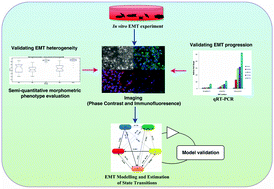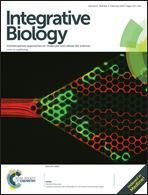Modeling continuum of epithelial mesenchymal transition plasticity†
Abstract
Living systems respond to ambient pathophysiological changes by altering their phenotype, a phenomenon called ‘phenotypic plasticity’. This program contains information about adaptive biological dynamism. Epithelial–mesenchymal transition (EMT) is one such process found to be crucial in development, wound healing, and cancer wherein the epithelial cells with restricted migratory potential develop motile functions by acquiring mesenchymal characteristics. In the present study, phase contrast microscopy images of EMT induced HaCaT cells were acquired at 24 h intervals for 96 h. The expression study of relevant pivotal molecules viz. F-actin, vimentin, fibronectin and N-cadherin was carried out to confirm the EMT process. Cells were intuitively categorized into five distinct morphological phenotypes. A population of 500 cells for each temporal point was selected to quantify their frequency of occurrence. The plastic interplay of cell phenotypes from the observations was described as a Markovian process. A model was formulated empirically using simple linear algebra, to depict the possible mechanisms of cellular transformation among the five phenotypes. This work employed qualitative, semi-quantitative and quantitative tools towards illustration and establishment of the EMT continuum. Thus, it provides a newer perspective to understand the embedded plasticity across the EMT spectrum.


 Please wait while we load your content...
Please wait while we load your content...